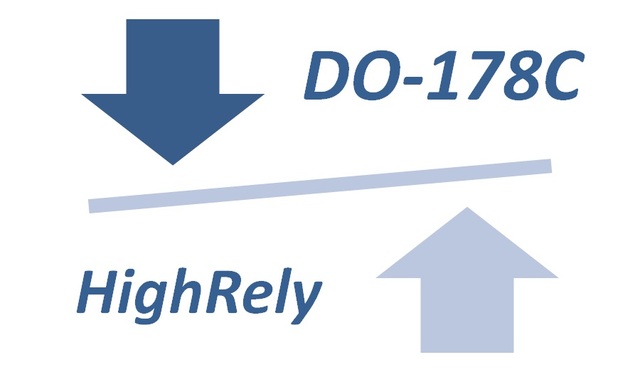DO-178C Synopsis: DO-178C Facts, DO-178C Resources, & DO-178C Answers
January 06, 2010 (PRLEAP.COM) Business News
DO-178C: the long awaited revision to DO-178B, addresses new avionics software development factors and will be required for new projects beginning in 2011. What is DO178C and where are DO-178C answers? HighRely's co-founder and author of the world's only published book on DO-178 ("Avionics Certification - A Complete Guide To DO-178 & DO-254"), Mr. Vance Hilderman provides the following DO-178C synopsis and additional resources. DO-178C is a modest update to DO-178B, whereas DO-178B was a substantial revision to DO-178A. DO-178B was developed to address serious safety-related shortcomings within the software engineering lifecycle for then-modern avionics systems. D0-178C by comparison aims to clarify areas of repeated misconception while addressing advances in complex avionics software development including formal methods for avionics, model-based development for avionics, object oriented technology for avionics, and qualification of certain tools used in avionics software development and verification. The core DO-178C document has relatively minor changes because the revisions are contained in supplements for each of the aforementioned topics. These DO-178C topics are summarized below (DO-178C Formal Methods, DO-178C Model Based Development, DO-178C Object Oriented Technology, and DO-178C Tool Qualification).
Resources for better understanding DO-178C and avionics development:
DO-178C and avionics whitepapers at: http://highrely.com/whitepapers.php
DO-178C Industry Group at: www.do178site.com
DO-178C and avionics Blogs at www.do178blog.com
DO-178C Training: public or private: http://highrely.com/DO178B_Training.php
DO-178 Process Templates & Checklists: http://highrely.com/JumpCert.php
DO-178C Traceability Tools: http://highrely.com/relytrace.php
DO-178C Project Management Tools: http://www.relycheck.com
Free DO-178C Answers (one free Q&A session to qualified engineers/companies): info@highrely.com
What is DO-178C for MBD (Model Based Development) and DO-178C for Object Oriented Technology? DO-178B preceded widespread usage of model-based development and object oriented technology for safety-critical applications such as avionics. Gradually, MBD and OOT were increasingly used, albeit less formally, via DO-178B. However, recent development tool advances coupled with gradual FAA acceptance means that DO-178C embraces a safely controlled use of object oriented technology and model based development. Specifically, DO-178C allows for controlled modeling and object oriented software in all avionics development, even Level A. DO-178C bounds the acceptability for MBD and OO, meaning discrete acceptability criteria are provided. DO-178C traceability is emphasized through the model, objects, and development lifecycle are mandated along with deterministic proof of type consistency across all possible run-time type instantiations (note that tools such as RelyTRACE for DO-178C traceability will become even more popular). Developers using OOT for DO-178C will need to ensure each subclass passes all types applicable to parent classes and also verify that each invocation is verified for all callable methods. Defined generics are allowed via DO-178C providing all run-time instantiations are verified and traced. DO-178B allows for all the above provided each aspect is fully detailed within the project's design standard (note that use of automated DO-178C project and checklist management via tools such as RelyCHECK will become more prevalent).
What is DO-178C for Formal Methods? DO-178C will, for the first time, officially recognize the validity of using Formal Methods within the avionics software development process. Subject to DO-178C guidelines, formal methods can be used to augment or replace verification steps which must normally be performed via DO-178B. Formal methods will be allowed to verify requirements correctness, consistency, and augment reviews. DO-178C source code reviews can utilize formal methods, particularly for auto-generated code (typically developed via Model Based Development; see above). Also, DO-178C will allow formal methods to verify or replace test cases used to verify low level requirements and replace some forms of testing via formal method based reviews. Ultimately, DO-178C allows the potential to use formal methods for model and code analysis to reduce avionics software testing.
What is DO-178C Tool Qualification? DO-178C changes DO-178B's overly simple "development tool or verification tool" categorization into three distinct criteria covering five tool qualification levels. The three DO-178C Tool Qualification Criteria are 1) Software Development Tools, 2) Software Verification Tools which also augment other development or verification activities, and 3) Software Verification-only tools. Additionally, there are five Tool Qualification Levels which are coupled with the above Tool Criteria to determine the specific qualification activities required; the Tool Qualification Levels are 1) Level A tools, 2) Level B tools, 3) Level C tools, 4) Tool Operational Requirements, Architecture, and Additional Verification, and 5) Tool Operational Requirements verification.
For additional information on DO-178C whitepapers or public/private DO-178C training there are multiple options - see the above links for additional references.
